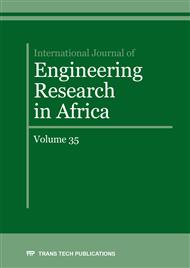[1]
J. Douthett, Nitronic family of nitrogen-bearing stainless steels. Metal Progress 108, 50-54 (1975).
Google Scholar
[2]
D. S. Bergstrom, J. M. Rakowski, C. P. Stinner, J. J. Dunn, J. F. Grubb. (Google Patents, 2017).
Google Scholar
[3]
J. Kennedy, R. Schulte, Nitrogen analysis in an electron beam welded austenitic stainless steel, Nitronic 33. Journal of Materials Science 15, 2925-2927 (1980).
DOI: 10.1007/bf00550564
Google Scholar
[4]
P. Schmidt et al., Residual surface stress: comparing traditional and modulated tool path machining processes. Materials Science and Technology 32, 1471-1483 (2016).
DOI: 10.1080/02670836.2016.1198113
Google Scholar
[5]
S. Dolinšek, Work-hardening in the drilling of austenitic stainless steels. Journal of Materials Processing Technology 133, 63-70 (2003).
DOI: 10.1016/s0924-0136(02)00245-5
Google Scholar
[6]
I. Korkut, M. Kasap, I. Ciftci, U. Seker, Determination of optimum cutting parameters during machining of AISI 304 austenitic stainless steel. Materials & Design 25, 303-305 (2004).
DOI: 10.1016/j.matdes.2003.10.011
Google Scholar
[7]
M. H. Ghan, M. A. Hashmi, M. Dhobe, A Review on Optimization of Machining Parameters for Different Materials. International Journal of Advance Research, Ideas and Innovations in Technology 3(2), 25-27 (2017).
Google Scholar
[8]
A. Milani, W. Dabboussi, J. Nemes, R. Abeyaratne, An improved multi-objective identification of Johnson–Cook material parameters. International Journal of Impact Engineering 36, 294-302 (2009).
DOI: 10.1016/j.ijimpeng.2008.02.003
Google Scholar
[9]
Armco, Armco Nitronic 33 Stainless Steel - Product Data Bulletin No. S-79. (1986).
Google Scholar
[10]
A. Mamalis, M. Horvath, A. Branis, D. Manolakos, Finite element simulation of chip formation in orthogonal metal cutting. Journal of Materials Processing Technology 110, 19-27 (2001).
DOI: 10.1016/s0924-0136(00)00861-x
Google Scholar
[11]
D. A. Stephenson, J. S. Agapiou, Metal cutting theory and practice. (CRC press, 2016).
Google Scholar
[12]
S. Kalpakjian, S. R. Schmid, Manufacturing engineering and technology. (Pearson Upper Saddle River, NJ, USA, 2014).
Google Scholar
[13]
V. A. Balogun, I. F. Edem, J. Bonney, E. Ezeugwu, P. T. Mativenga, Effect of Cutting Parameters on Surface Finish when Turning Nitronic 33 Steel alloy. International Journal of Scientific & Engineering Research 6, 560-568 (2015).
Google Scholar
[14]
I. H. Mulyadi, V. A. Balogun, P. T. Mativenga, Environmental performance evaluation of different cutting environments when milling H13 tool steel. Journal of Cleaner Production 108, 110-120 (2015).
DOI: 10.1016/j.jclepro.2015.07.024
Google Scholar
[15]
B. Juneja, Fundamentals of metal cutting and machine tools. (New Age International, 2003).
Google Scholar
[16]
J. F. Jenkins, Validation of Nitronic 33 in Reinforced and Prestressed Concrete,, (NAVAL CIVIL ENGINEERING LAB PORT HUENEME CA, 1987).
Google Scholar
[17]
Carlson. Carlson Nitronic® 33® Austenitic Stainless Steel 1998 [cited 2014; Available from:http://www.matweb.com/search/datasheettext.aspx?matguid=c85f494435b0468f9a5ee4d021cef5a0.
Google Scholar
[18]
J. Hu, Y. K. Chou, Characterizations of cutting tool flank wear-land contact. Wear 263, 1454-1458 (2007).
DOI: 10.1016/j.wear.2007.01.080
Google Scholar
[19]
L. Jiang, Å. Roos, P. Liu, The influence of austenite grain size and its distribution on chip deformation and tool life during machining of AISI 304L. Metallurgical and Materials Transactions A 28, 2415-2422 (1997).
DOI: 10.1007/s11661-997-0198-z
Google Scholar


